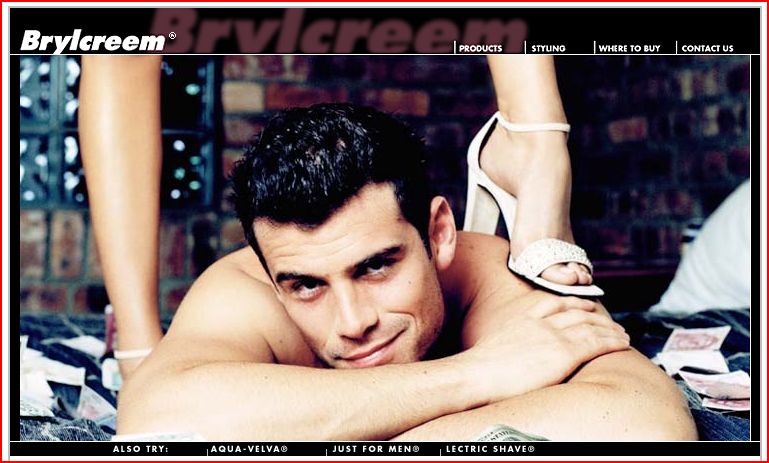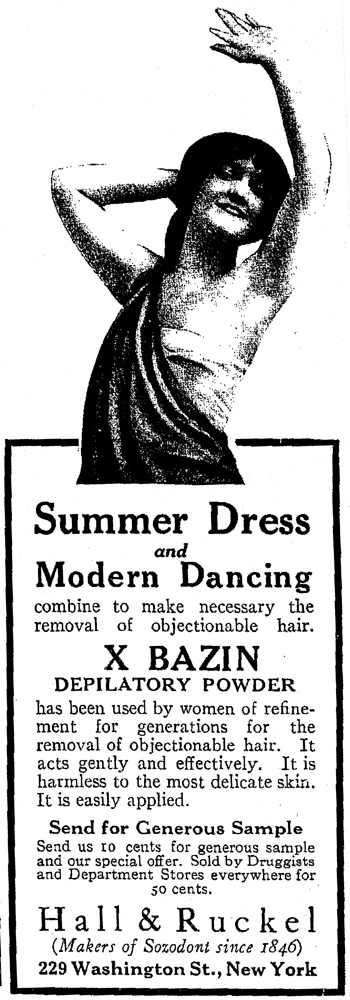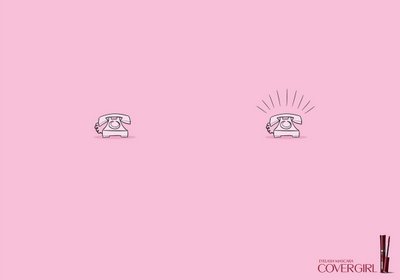Laura K. brought our attention to these ads with not-so-subliminal sexual content (via haha.nu). Some of them are so-not-so-subliminal that they may not be safe for work.
bodies: hygiene
The relationship between clear skin and sexuality has an interesting history. In an effort to establish dermatology as a medical subspeciality, aspiring dermatologists strategically linked, in the popular imagination, young women’s acne and lasciviousness. Doctors argued that acne was a sign of sexual desire or God forbid, masturbation or worse. Parents worried, then, that this would make their daughters unacceptable marriage partners (at a time when that was disasterous for women) and so would pay a great deal of money to doctors who would promise to cure their daughters of this scarlet dot. Thus, dermatology was born.
Later, of course, acne became seen as a boy’s issue… But since we had different expectations for boys (in terms of both beauty and sexuality), acne was seen as a “stage” to be endured instead of a “problem” to be cured. This is more or less like it was when I was a kid in the 1980s.
But today, of course, clear skin is linked to sexual attractiveness, especially for women (thanks, in part, to our friend evolutionary psychology). And, with dermatologists at their beck and call, upper class teenagers (and adults) no longer have to endure bad skin. Thus, science, sex and skin care seem like natural bed fellows. Consider this ad:
It’s a subtle threat: “Why not wake up in great skin.” Why would we care? Who is laying next to you? Does he know what you look like without make-up? Without beer goggles? Without make-up and beer goggles!? And what happens if he finds you disgusting in the bright light of morning? (This, of course, is a very effective marketing tool because sexual attractiveness is linked to happiness. There is a price to pay for not finding a mate and, we are told over and over and over, that price is very high.)
I also see in the ad a perpetuation of the medicalization of sexual desirability (whether that be “purity” or “beauty”). The “3-step skin care” and “consultation” is a subtle medicalizing and scientizing of the make-up industry. Lots of make-up companies use the notion of “science” to market their product (i.e., “Prescriptives”) and many of them link this with what is “natural” as well (i.e., Aveda).
Thanks to Jason for sending along the image!
Miguel sent us a link to Galeria: Ellas Mandan, a set of advertisements that reverse the common images of male dominance by showing women in control:

For pantyhose:

Shoes:
Jeans:
Dolce & Gabbana:
A submission from Stumblng Tumblr from the Brylcreem website:
NEW! A fashion ad from Phillip G.:
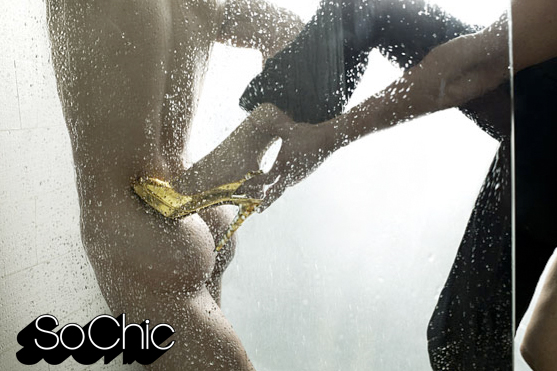
These images show women in “control” of, or dominating men, but in a very sexualized manner that often references S&M or bondage. So women can have power, but have to be sexualized at the same time. This fits in well with our cultural beliefs that women have power over men because men want sex and will allow themselves to be manipulated by women in order to get it. So women can supposedly control men by threatening to withhold sex until they get what they want.
And is it not possible to just have some images where men and women are equals and no one has to be dominant? Is that out of the question?
Thanks, Miguel!

This “Onslaught” ad by Dove has garnered a lot of attention and positive press:
The idea, of course, is that we need to protect our daughters from the images that may harm their self-esteem or make them uncomfortable about their bodies. A great message, no doubt.
However, corporate activism usually has limits and contradictions (as do most things in life, really). Miguel sent us this ad spoof that points out that many of the images the Dove ad says we should be protecting our daughters from are actually used in Axe ads–and Axe is owned by Unilever, the same company that owns Dove.
So Unilever manages to target both markets–those who respond to sexualized images and those who find them harmful–through different brands. This is a common tactic–because large multinational companies own so many different brands, they can market to many different groups of consumers; when we reject one product because of its production process or advertising and buy another instead, there’s a very good chance we’re buying from the same corporate entity, just a different brand name.
As one blogger nicely put it:
It’s a parent’s responsibility to make sure the damaging messages they themselves produce don’t reach your kids.
That is, Dove is telling parents to protect their kids, as if Dove CARES, but Dove’s parent company is producing those very same messages. (It’s kind of like a single corporation owning a beer company and running Alcoholics Anonymous. How very convenient for both.)
A commenter pointed out that Greenpeace made an ad based on Dove’s “Onslaught” commercial that brings up the effects of palm oil production in the destruction of forests in Indonesia:
Thanks, Dangger!
NEW: There is a terrific post at Moment of Choice about one woman’s experience auditioning for a Dove Real Woman commercial. From the post:
Under the guise of looking for women who felt truly comfortable in their own skin, no matter what they looked like, they asked us to bare all or most of it, to prove just how comfortable we really were…A young peppy assistant demonstrated how they wanted us to shake our hands in the air like we just didn’t care and do a full 360 for the camera and male judging panel.
It’s a fascinating inside look at a process most of us never take part in, and reinforces the fact that corporate activism often covers an awful lot of business-as-usual behind the scenes.
It is a norm for women in the U.S. to shave their armpits, but this is not the norm elsewhere, even in countries that have relatively a lot in common with the U.S. (like France I’ve been corrected). How did armpit shaving become the norm in the U.S.? And who benefited from this?
Vee the Monsoon sent us the following commentary and ad. It turns out, women shave in the U.S. today, in part, because of a concerted marketing effort on the part of companies that stood to profit from the creation of such a norm with the creation of anxiety about “objectionable hair.”
From The Straight Dope:
…U.S. women were browbeaten into shaving underarm hair by a sustained marketing assault that began in 1915. (Leg hair came later.) The aim of… the Great Underarm Campaign was to inform American womanhood of a problem that till then it didn’t know it had, namely unsightly underarm hair. To be sure, women had been concerned about the appearance of their hair since time immemorial, but (sensibly) only the stuff you could see. Prior to World War I this meant scalp and, for an unlucky few, facial hair. Around 1915, however, sleeveless dresses became popular, opening up a whole new field of female vulnerability for marketers to exploit…. the underarm campaign began in May, 1915, in Harper’s Bazaar, a magazine aimed at the upper crust. The first ad ‘featured a waist-up photograph of a young woman who appears to be dressed in a slip with a toga-like outfit covering one shoulder. Her arms are arched over her head revealing perfectly clear armpits. The first part of the ad read “Summer Dress and Modern Dancing combine to make necessary the removal of objectionable
hair.
From the May 1915 issue of Harper’s Bazaar:
Thanks Vee!
NEW! Another example from the U.K., 1934 (found here). This one encourages the dissolving of armpit hair as a way to fight armpit odor:
Toothpaste and tampons designed with your skin color “in mind.” MultiCult Classics says:
OK, Pantene offers products designed with Black women in mind. But Crest, Always and Tampax?
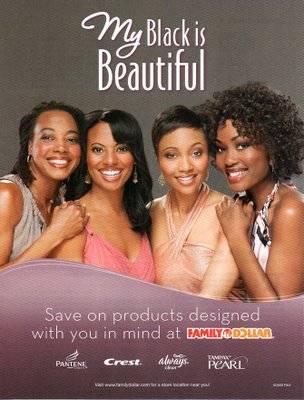 Also, apparently the black that is beautiful is light-skinned, with supposedly “European” facial features. See also: black models that don’t look black.
Also, apparently the black that is beautiful is light-skinned, with supposedly “European” facial features. See also: black models that don’t look black.
UPDATE: In the comments, Brian asked what I mean by “reification.” Thanks for the question, Brian! I mean “treating an abstraction as if it were real.” And, yep, race isn’t real. See racial categories as a historical artifact and check out this great website by the American Anthropological Association.
As I re-read… the contradiction between the two last paragraphs (black models that look white and there’s no such thing as black and white) is awesomely reflective of the reality of its race and its simultaneous non-reality!
.
Here’s a strange Australian ad for U, a feminine hygiene product. It shows women hanging out with beavers…the animal type, of course. Men look on approvingly, so I guess the message is if you take appropriate care of your girly bits, men will like you.
Here’s the website.
Might be good for a discussion of hygiene and women’s bodies or the history of feminine hygiene products and the way we think about menstruation.
Thanks, Patrick C.!
Found here.
The relationship between clear skin and sexuality has an interesting history. In an effort to establish dermatology as a medical subspeciality, aspiring dermatologists strategically linked, in the popular imagination, young women’s acne and lasciviousness. Doctors argued that acne was a sign of sexual desire or God forbid, masturbation or worse. Parents worried, then, that this would make their daughters unacceptable marriage partners (at a time when that was disasterous for women) and so would pay a great deal of money to doctors who would promise to cure their daughters of this scarlet dot. Thus, dermatology was born.
Later, of course, acne became seen as a boy’s issue… But since we had different expectations for boys (in terms of both beauty and sexuality), acne was seen as a “stage” to be endured instead of a “problem” to be cured. This is more or less like it was when I was a kid in the 1980s.
But today, of course, clear skin is linked to sexual attractiveness, especially for women (thanks, in part, to our friend evolutionary psychology). And, with dermatologists at their beck and call, upper class teenagers (and adults) no longer have to endure bad skin. Thus, science, sex and skin care seem like natural bed fellows. Consider this ad:
It’s a subtle threat: “Why not wake up in great skin.” Why would we care? Who is laying next to you? Does he know what you look like without make-up? Without beer goggles? Without make-up and beer goggles!? And what happens if he finds you disgusting in the bright light of morning? (This, of course, is a very effective marketing tool because sexual attractiveness is linked to happiness. There is a price to pay for not finding a mate and, we are told over and over and over, that price is very high.)
I also see in the ad a perpetuation of the medicalization of sexual desirability (whether that be “purity” or “beauty”). The “3-step skin care” and “consultation” is a subtle medicalizing and scientizing of the make-up industry. Lots of make-up companies use the notion of “science” to market their product (i.e., “Prescriptives”) and many of them link this with what is “natural” as well (i.e., Aveda).
Thanks to Jason for sending along the image!
Miguel sent us a link to Galeria: Ellas Mandan, a set of advertisements that reverse the common images of male dominance by showing women in control:

For pantyhose:

Shoes:
Jeans:
Dolce & Gabbana:
A submission from Stumblng Tumblr from the Brylcreem website:
NEW! A fashion ad from Phillip G.:

These images show women in “control” of, or dominating men, but in a very sexualized manner that often references S&M or bondage. So women can have power, but have to be sexualized at the same time. This fits in well with our cultural beliefs that women have power over men because men want sex and will allow themselves to be manipulated by women in order to get it. So women can supposedly control men by threatening to withhold sex until they get what they want.
And is it not possible to just have some images where men and women are equals and no one has to be dominant? Is that out of the question?
Thanks, Miguel!

This “Onslaught” ad by Dove has garnered a lot of attention and positive press:
The idea, of course, is that we need to protect our daughters from the images that may harm their self-esteem or make them uncomfortable about their bodies. A great message, no doubt.
However, corporate activism usually has limits and contradictions (as do most things in life, really). Miguel sent us this ad spoof that points out that many of the images the Dove ad says we should be protecting our daughters from are actually used in Axe ads–and Axe is owned by Unilever, the same company that owns Dove.
So Unilever manages to target both markets–those who respond to sexualized images and those who find them harmful–through different brands. This is a common tactic–because large multinational companies own so many different brands, they can market to many different groups of consumers; when we reject one product because of its production process or advertising and buy another instead, there’s a very good chance we’re buying from the same corporate entity, just a different brand name.
As one blogger nicely put it:
It’s a parent’s responsibility to make sure the damaging messages they themselves produce don’t reach your kids.
That is, Dove is telling parents to protect their kids, as if Dove CARES, but Dove’s parent company is producing those very same messages. (It’s kind of like a single corporation owning a beer company and running Alcoholics Anonymous. How very convenient for both.)
A commenter pointed out that Greenpeace made an ad based on Dove’s “Onslaught” commercial that brings up the effects of palm oil production in the destruction of forests in Indonesia:
Thanks, Dangger!
NEW: There is a terrific post at Moment of Choice about one woman’s experience auditioning for a Dove Real Woman commercial. From the post:
Under the guise of looking for women who felt truly comfortable in their own skin, no matter what they looked like, they asked us to bare all or most of it, to prove just how comfortable we really were…A young peppy assistant demonstrated how they wanted us to shake our hands in the air like we just didn’t care and do a full 360 for the camera and male judging panel.
It’s a fascinating inside look at a process most of us never take part in, and reinforces the fact that corporate activism often covers an awful lot of business-as-usual behind the scenes.
It is a norm for women in the U.S. to shave their armpits, but this is not the norm elsewhere, even in countries that have relatively a lot in common with the U.S. (like France I’ve been corrected). How did armpit shaving become the norm in the U.S.? And who benefited from this?
Vee the Monsoon sent us the following commentary and ad. It turns out, women shave in the U.S. today, in part, because of a concerted marketing effort on the part of companies that stood to profit from the creation of such a norm with the creation of anxiety about “objectionable hair.”
From The Straight Dope:
…U.S. women were browbeaten into shaving underarm hair by a sustained marketing assault that began in 1915. (Leg hair came later.) The aim of… the Great Underarm Campaign was to inform American womanhood of a problem that till then it didn’t know it had, namely unsightly underarm hair. To be sure, women had been concerned about the appearance of their hair since time immemorial, but (sensibly) only the stuff you could see. Prior to World War I this meant scalp and, for an unlucky few, facial hair. Around 1915, however, sleeveless dresses became popular, opening up a whole new field of female vulnerability for marketers to exploit…. the underarm campaign began in May, 1915, in Harper’s Bazaar, a magazine aimed at the upper crust. The first ad ‘featured a waist-up photograph of a young woman who appears to be dressed in a slip with a toga-like outfit covering one shoulder. Her arms are arched over her head revealing perfectly clear armpits. The first part of the ad read “Summer Dress and Modern Dancing combine to make necessary the removal of objectionable
hair.
From the May 1915 issue of Harper’s Bazaar:
Thanks Vee!
NEW! Another example from the U.K., 1934 (found here). This one encourages the dissolving of armpit hair as a way to fight armpit odor:
Toothpaste and tampons designed with your skin color “in mind.” MultiCult Classics says:
OK, Pantene offers products designed with Black women in mind. But Crest, Always and Tampax?
 Also, apparently the black that is beautiful is light-skinned, with supposedly “European” facial features. See also: black models that don’t look black.
Also, apparently the black that is beautiful is light-skinned, with supposedly “European” facial features. See also: black models that don’t look black.
UPDATE: In the comments, Brian asked what I mean by “reification.” Thanks for the question, Brian! I mean “treating an abstraction as if it were real.” And, yep, race isn’t real. See racial categories as a historical artifact and check out this great website by the American Anthropological Association.
As I re-read… the contradiction between the two last paragraphs (black models that look white and there’s no such thing as black and white) is awesomely reflective of the reality of its race and its simultaneous non-reality!
.
Here’s a strange Australian ad for U, a feminine hygiene product. It shows women hanging out with beavers…the animal type, of course. Men look on approvingly, so I guess the message is if you take appropriate care of your girly bits, men will like you.
Here’s the website.
Might be good for a discussion of hygiene and women’s bodies or the history of feminine hygiene products and the way we think about menstruation.
Thanks, Patrick C.!





